The Magazine (LL) Historical Report, Block 12 Building 9Originally entitled: "Guns (Cannon) That are Mentioned as Having Been Stored in the Williamsburg, Virginia Powder Magazine at Various Times"
Colonial Williamsburg Foundation Library
Williamsburg, Virginia
1990
property of Williamsburg Chapter Association for the Preservation of Virginia Antiquities
Comment by Junior Historian Borresen to accompany
Guns (cannon) that are mentioned as having
been stored in the Williamsburg, Virginia,
Powder Magazine at various times.
After carefully checking all the letters mentioning guns contained in the typewritten volume THE POWDER MAGAZINE by the Research & Record Department, Colonial Williamsburg, Inc., and checking all the English ordnance regulations from the late 17th century to 1764, I am convinced that the proper type of gun to be placed in the powder magazine is that of the early period, using the ordnance regulation of not later than 1736, the gun to be cast in brass. See picture #6405, attached to report.
In suggesting a gun of that period which actually covers the period from about 1714 to 1748, I have taken the advantage of the over-lapping period. This over-lapping period is caused by continuous experiment being carried on. For instance, when the 1697 regulation was adopted and cast as standard ordnance, experimentation continued for new and improved guns. As the new guns had to be tried in the field in order to be compared with the standard type, two types of guns were being cast and used at the same time. Then the new types of guns were approved in 1736, they would be considered as standard until the new regulation was adopted. The new regulation came out in 1753. This is the basis and reason for suggesting the gun of 1736 regulation.
The decision of the caliber of the gun to be cast I am leaving to the Society which is financing the project.
The old cannon balls found in the powder magazine yard consisted of the three calibers - 3- 4- and 6-pounders. As the 3- and 6-pounders were standard field guns, either one will be correct to use. The 6-pounder would be 8 feet in length and 19-0-0 (2128 pounds) in weight. The 3-pounder would be 7 feet in length and 11-2-0 (1288 pounds) in weight.
Thor Borresen, Junior Historian
February 11, 1938DEPARTMENT OF THE INTERIOR
NATIONAL PARK SERVICE
COLONIAL NATIONAL HISTORICAL PARK
YORKTOWN, VIRGINIA
OFFICE OF THE SUPERINTENDENT
February 11, 1938
Guns (cannon) that are mentioned as having been stored in the Williamsburg, Virginia, Powder Magazine at various times.
This report has been written upon the request of the Association for the Preservation of Virginia Antiquities regarding the type and caliber of guns mentioned in the old journals and letters of early Williamsburg. There are three letters which particularly mention the Williamsburg powder magazine and form the basis of this report. They are quoted here. as taken from the typewritten volume THE POWDER MAGAZINE, by Harold R. Shurtleff, Director, Department of Research & Record, Colonial Williamsburg, Inc. The three letters can be found on pages 9, 29 and 90 of the above-mentioned volume. The last of these letters is dated 1776.
There are other letters in the same typewritten volume, but they date around the Revolutionary War and deal mostly with the guns of that period.
As Colonial National Historical Park, Yorktown, Virginia, will eventually gather all possible knowledge and descriptions of the ordnance regulations of the three countries involved in the Revolutionary War, which covers the latter part of the eighteenth century, this report has been written on the basis of the early to the middle of the eighteenth century and more in keeping with the dates of the construction of the powder magazine and the aforementioned letters relating to it.
The first letter mentioning guns is on page 9 -
(Brock, R. A. editor)
Official Letters of Alexander Spotswood
from Manuscripts in the Virginia Historical Society, Richmond 1885,
Volume 2. page 140.Virginia Feb'y 16th, 1715 (1716)
To the L'ds Comm'rs of Trade:…
I have heretofore transmitted to y'r Lo'ps' Board an acct of all the Stores of War within this Colony; all that has been sent since my Arrival here are 300 fire locks, 300 Soldiers' tents, 154 barrels of Powder, 2 3 Ton 7 lb. of Musq't ball, 2, field-pieces, [italics by writer] with their Carriages [italics by writer] and furniture, all w'ch are in good order, but as I am now removing all the small Arms and Stores into a new Magazine, lately built here,…
The guns here mentioned would have been of the 1697 or the 1736 regulations, but no later than 1736. The use of the 1736 regulation is based on the over-lapping period of each regulation, viz., when the 1697 regulation was adopted, experiment would continue on new and lighter guns. As quoted by John Muller, A Treatise of Artillery, Introduction, page 12, "…and it may so happen that the heavy pieces cannot be carried through bad roads, as in America,…". This experiment on new and lighter guns would be carried out in the field as well as on the proof butts. Consequently there were two types of guns in the field — the standard and the experimental guns. When the new 1736 regulation was established the new guns would have been used sufficiently to have proved their superiority over the old standard type. The possibility of some of those guns having reached the colonies in the early part of the eighteenth century is not so remote.
The second letter mentioning guns is on page 29 -
Journals of the House of Burgesses of Virginia
1761-65, Volume 30, page 306Thursday, the 20th of December, 5 Geo. iii. 1764
Mr Attorney, from the Committee to whom the Representation of George Pitt, Keeper of the publick Magazine in the City of Williamsburg was referred, reported that they had examined into the State of the said Magazine, and public military Stores contained therein, and had agreed to the following Report thereupon.
It appears to your Committee that there are now in the said Magazine two Brass Cannon and two Brass Mortars, which are useless; also about 13,000 lbs. of Gunpowder,…
The possibility is that the two guns here mentioned are the same ones referred to in the first letter. If so, the mention of brass guns would eliminate the use of iron guns. The remark of their being useless 3 would mean that they must have been there for a long time. This also eliminates the 1764 regulation. Being made of brass the guns would not have been useless; they could easily have been cleaned. Most likely the carriages had rotted and needed to be replaced.
The third letter mentioning guns is on page 90
Virginia Gazette
John Pinkney, ed.January 10, 1776.
Mr. Pinkney,
I understand our honorable convention has given direction to have the cannon in the magazine put in order: this step must be highly approved by every well wisher to his country,…
Again this can be considered as the same gun. The age of the gun (62 years, 1714-1776) does not necessarily mean that the gun would be useless, as brass deteriorates only slightly. During the siege of Yorktown many of the English guns used there dated from 1727 to 1740. Several of those guns have been presented to the Colonial National Historical Park and will soon be mounted in the various restored batteries. They all bear the inscription, "Surrendered under the Capitulation of Yorktown Oct. 19, 1781". The deterioration of these guns is hardly noticeable, although their present age is 210 years.
The following is a description of the 1736 English ordnance regulation, known, also, as the "General Armstrong Regulation", (General Armstrong was at that time surveyor general of ordnance).
The writer of this report did not have access to the original Armstrong volume, but has copied the text of dimensions and proportion as given in a book written by John Muller, A Treatise of Artillery, (printed for John Millan, Whitehall, London, 1766), pages 70 to 75:
…As most constructions of authors agree in general, and differ only in some particulars, we shall give here that of General Armstrong's, formerly Surveyor General of the Ordnance, which appears to me less deficient than any that have hitherto been given, either here or abroad; which are as follows.
General RULE for brass and iron Guns.
The length of the Gun being divided into 7 equal 4 parts; the length of the first reinforce AE, is two of these parts; the second EF, one, and a diameter of the bore; so that the chace, F B, is four of these parts, wanting a diameter of the bore.The distance from the hind part of the base ring, to the beginning of the bore, that is, the breech A C, is always equal to the thickness of the metal at the vent. The trunnions T, are always a calibre in length, and as much in diameter, clear of the second reinforce ring, and placed in such a manner, that a right line drawn thro' their centres touches the lower part of the bore, as may be seen in the fourth figure, where that line is marked by a b, and passing thro' the third division; that is to be three sevenths from the hind part of the base ring. The length of the cascable A h, is always two calibres and a quarter.
These divisions are in general made by all nations, only the trunnions are placed half a calibre more backward by the French.*
General dimensions for brass Guns.
The calibre of the Gun is divided into 16 equal parts. The thickness of metal at the base ring from the bore is, 16. At the end of the first reinforce ring, 14.5 At the same place, for the beginning of the second reinforce, 13.5 At the end of the second reinforce, 12.5 At the same place for the beginning of the chace, 11.5 At the end of the chace or muzle, the mouldings excluded, 8.
MOULDINGS Breadth of the base-ring, 1.5 inches. Breadth of the ogee, next to the base-ring 2. From the ogee to the fore part of the astragal, a calibre. The fillets of the astragal, are each .28 The astragal, or half-round, .56 Total of the astragal and fillets, 1.12 At the first and second reinforce ring, the fillets are .25 5 Breadth of the first and second reinforce rings, 1.25 The ogees next to these rings, 1.5 The fillets at the muzle, .25 The muzle ogee, in a 12 pounder and upwards, is 1.25 inches, but in a 9 pounder and under, it is an inch only. The chace girdle and astragal is one calibre. The space from the mouth of the Gun to the muzle astragal, in an 18 pounder and upwards, is equal to a diameter of the second reinforce ring; but in a 12 pounder and under, it is equal to the diameter of the first reinforce ring.
The rising of the mouldings at the first and second reinforces, is an eighth of an inch; and the rising of the base ring is determined by laying a ruler to the extremities of the first and second reinforce mouldings. The swelling of the metal at the muzle is always equal to the diameter of the second reinforce ring.
CASCABLE. From the hind part of the base ring, to the fore part of the fillet next to the button, ? of a calibre. From the fore part of the fillet next to the button, to the centre of the button, one calibre. From the hind part of the base ring, to the hind part of the fillet, between the two* ogees, 1/6 of a calibre. Diameter of the fillet next to the button, 1.5 calibre. Diameter of the neck, ¾ of a calibre. Diameter of the button, something more than a calibre, it is six inches in a 24 pounder. It must be observed, that the shell at the vent is 3 inches broad, and reaches from the base ring, to within a quarter of an inch of the vent astragal, leaving that space for the ease of turning, and the vent is a fifth part of an inch.
General dimensions for iron GUNS. The calibre of the Gun is here divided into 14 equal parts. The thickness of metal at the vent from the bore, is 16 parts. At the end of the first reinforce, 14.5 At the beginning of the second reinforce 13.5 6 At the end of the second reinforce, 12.5 At the beginning of the chace, 11.5 At the end of the chace or muzle, 8. As to the mouldings, and the rest of the dimensions they are much the same as before, only the diameter of the vent is here one fourth of an inch, without any reason given for it.
The lengths of the Guns, according to this gentleman, were as follows; the 32 pounder brass, 10 feet; the 24 and 18 pounders, 9.5 feet; the 12 pounder, 9; the six, 8; the three,7; and the 1.5 pounder, 6 feet.
The iron 32 pounder, 9.5 feet; the 24 and 18 pounders, 9; the 12, eight; the 8, seven; the 6, six and half; and the 3, four and half feet.
Some of these dimensions have been altered since for others, grounded upon no better reason than the former.
The reader may easily perceive the perplexity of these constructions, arising from the different scales that are used without the least necessity. That the greatest part of the mouldings should have the same dimensions, from a 3 pounder, to one of 32, appears contrary to reason, and especially contrary to the rules of architecture; from whence they have been taken. To make as many mouldings in iron Guns, which are rough and not turned, as in brass ones, is another blunder; but these are trifles, in regard to the absurdities in general committed in these constructions; which cannot better be discovered, than by examining all the parts separately, each in their order.
Photograph #6405, attached to this report, shows the brass and iron gun as drawn from the dimensions given in the citation from Muller above. The period of the Armstrong regulation can be considered to extend from 1700 to 1753, and in the following order: the experimental stage from 1697 to 1736; standard regulation from 1736 to 1753.
When the yard of the powder magazine was excavated a considerable number of cannon balls were found. Their diameters are:
| 3-pounder | (2.775) |
| 4-pounder | (3.053) |
| 6-pounder | (3.598) |
The 4-pounder is very seldom mentioned as a field piece. It is mostly 7 connected with garrison ordnance. On the other hand, the 3- and the 6-pounder were standard field guns. The dimensions of the 1736 regulation guns were:
| 6-pounder, brass | |
| Length 8 feet | |
| Weight - 19-0-0 (2128 pounds) | |
| 3-pounder, brass | |
| Length - 7 feet | |
| Weight - 11-2-0 (1288 pounds) |
In letter "2", dated 1764 there is mention of two brass mortars. No dimensions are given, but most likely they were small royals (5.8") or Cohorn (4.6"). See photograph #6404, which shows the mortars and their beds of a slightly later date than the guns.
Of iron guns there are several types and dimensions, even though they are of the same caliber. For instance, of naval guns there are light, medium, light-medium, and heavy. The garrisons were mostly heavy, but there are some light 6- and 3-pounders experimented with for the field.
There is in Williamsburg, on the campus of William and Mary College, a light 6-pounder of late seventeenth or early eighteenth century manufacture. This design of gun was cast before the Armstrong regulation of 1736, and is a naval or a garrison gun. Photograph #6403, gun No. 2, is similar in design. The gun from which this drawing was made can be found in fort McHenry, Baltimore, Maryland. The same photograph shows two other guns (Nos. 1 and 5), one light and one medium. They are both of a later period — about 1748.
There is only a slight difference in the architectural design of the Armstrong gun and the one of 1748. On the Armstrong gun there are two ogees on the cascabel, whereas on the type of 1748 there is only one.
The next English ordnance regulation came out in 1753. See photograph #5145. None of the lighter guns listed in these tables would have arrived. in the colonies until late in the 1740's.
Photograph #4802 is of the carriage, and #4806 of the wheels and furniture for a gun of the Armstrong period.
Photograph #6402 is of a light 6-pounder, brass gun and carriage of the 1753 regulation.
NOTES ON BRASS AND IRON GUNS
Photograph #6405
The drawing of the two guns here shown was made from the description 8 given in John Muller, A Treatise of Artillery, pages 70 to 75, quoted above. This type of gun was known as General Armstrong Regulation, or the English Ordnance Regulation of 1736.
The iron gun is plain, with no ornaments or decorations. The brass gun has the royal coat of arms of George 1, 1714-1727, on the breech, with the coat of arms of the Master General of Ordnance, John, Duke of Argyll and Greenwich, June 3, 1725 - May 10, 1727, on the chase, and the name of the maker, and the date when cast, on the base ring.
The placing of the royal and the Master General's coats of arms on the guns is not mentioned by John Muller in his description of the Armstrong guns, but we have in the Colonial National Historical Park thirteen of the original guns, all having the coats of arms of the various ordnance generals and rulers, dating from 1727 to 1767, showing that this was the usual custom of decorating brass guns.
The coats of arms on the drawing were taken from an 8" howitzer at Colonial National Historical Park, as was the maker's name, Schalch. Andrew Schalch was born in Schauffhausen in 1692. He learned gun founding in Douay, Flanders, and at the age of twenty-four was placed in charge of rebuilding the royal foundry and arsenal at Woolwich, where he remained from September 29, 1716 to 1770, when he was retired.
BIBLIOGRAPHY
- Foulkes, Charles, The Gun founders of England The University Press, Cambridge, 1937. Pages 59-66, 77.
- Muller, John, A Treatise of Artillery Printed for John Millan, Whitehall, London, 1756. Pages 70-75; plates 8, 9 and 21; Introduction, p. 12.
- Smith, Captain George, An Universal Military Dictionary Printed for John Millan, near Whitehall, London, 1779. Page "can-can".
- Tousard, Louis de, American Artillerists Companion Published by C. and A. Conrad & Go., Philadelphia, 1809. 2 volumes. Volume 1, pp. 131 (footnote), 135-136, 201-203.
Photographs of gun drawings were made from drawings on file in the Division of Historical Service, Colonial National Historical Park, Yorktown, Virginia.
Thor Borresen
Junior Historian
Footnotes
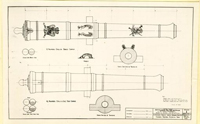 Photograph #6405
Photograph #6405
English brass and iron 12-pounder, period of 1736, (General Armstrong regulation).
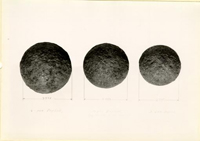 Photograph #6280
Photograph #6280
Three different types of cannon balls found buried in the
Powder magazine yard. A 6-, a 4-, and a 3-pounder.
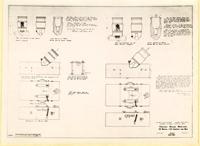 Photograph #6404
Photograph #6404
English, brass, 4.6 Cohorn, and 5.8, Royal, mortars and mortar beds. Period of 1736-1753.
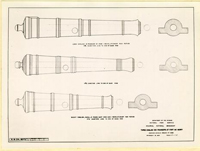 Photograph #6403
Photograph #6403
Three cast 6-pound, English.
#1-Medium light, period 1748
#2-Light, period 1697-1736
#3-Light, period 1748
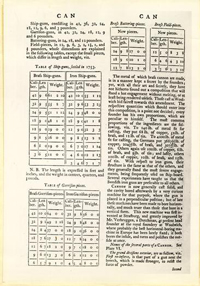 Photograph #5145
Photograph #5145
Table of guns as adopted in the English ordnance regulation of 1753. Photocopy from Captain George Smith, A Universal Military Dictionary, (Whitehall, London, 1779).
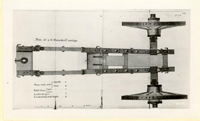 Photograph #4802
Photograph #4802
English, 6-pounder carriage. Photocopy of Plate 8, page 174, in John Muller, A Treatise of Fortification, (London, 1756). See, also, photograph #4806.
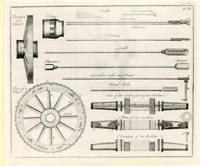 Photograph #4806
Photograph #4806
English gun carriage wheels, axles, and accoutrements. Photocopy of Plate 9, page 180, in John Muller, A Treatise of Artillery, (London, 1756).
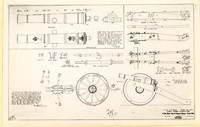 Photograph #6402
Photograph #6402
English 6-pounder, brass, field gun and carriage. Period, 1753-1764.